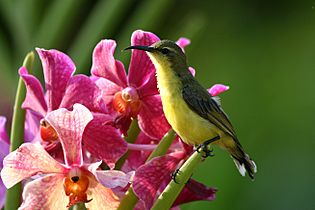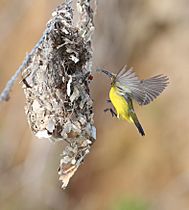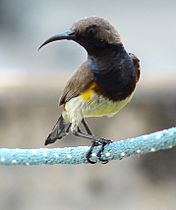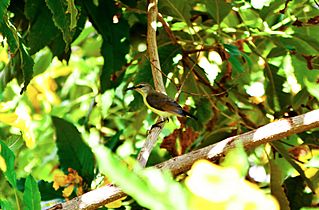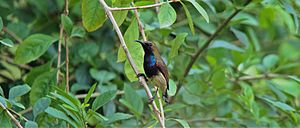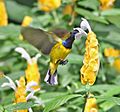Olive-backed sunbird facts for kids
Quick facts for kids Olive-backed sunbird |
|
|---|---|
 |
|
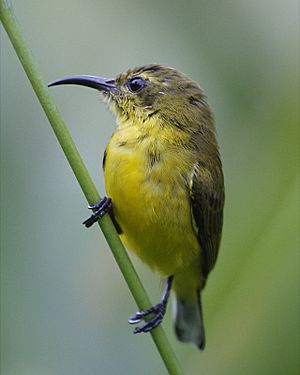 |
|
| Male and female in Singapore | |
| Conservation status | |
| Scientific classification | |
| Genus: |
Cinnyris
|
| Species: |
jugularis
|
| Synonyms | |
|
|
The olive-backed sunbird (Cinnyris jugularis), also called the yellow-bellied sunbird, is a small, colorful bird. You can find it in many places, from South Asia all the way to Australia. These birds are known for their bright yellow bellies and their love for nectar.
Contents
About the Olive-backed Sunbird
Scientists give every living thing a special name. This helps them study and understand different species. The olive-backed sunbird's scientific name is Cinnyris jugularis. A long time ago, in 1766, a Swedish scientist named Carl Linnaeus first gave this bird its scientific name.
Today, we know there are many different types, or subspecies, of the olive-backed sunbird. Scientists are still learning if some of these might even be completely separate species!
What They Look Like
Olive-backed sunbirds are small songbirds. They are usually about 12 centimeters (about 5 inches) long. Most of them have bright yellow undersides and dull brown backs.
The adult male has a dark, shiny blue-black color on its forehead, throat, and upper chest. In some places, like the Philippines, males might have an orange band on their chest. Other males in different areas can have blackish or grayish-white undersides.
Where They Live
The olive-backed sunbird is very common across southern China and Southeast Asia. You can also find them in Queensland, Australia, and the Solomon Islands.
These birds originally lived in mangrove forests. But they have learned to live near people very well. Now, you can often see them even in busy cities. They sometimes even build their nests inside human homes!
How They Behave
Reproduction and Life Cycle
Olive-backed sunbirds mate at different times of the year depending on where they live. In the Northern Hemisphere, they mate between April and August. In the Southern Hemisphere, it's between August and January.
Both the male and female birds work together to build their nest. The nest looks like a flask, with a little porch over the entrance. It often has a trail of hanging material at the bottom.
After building the nest, the birds leave it alone for about a week. Then, the female returns to lay one or two greenish-blue eggs. The eggs hatch after about another week. The female stays on the nest to keep the eggs warm, but she might leave for short times during the day. Once the chicks hatch, both parents help take care of them. The young birds usually leave the nest about two or three weeks later.
What They Eat
Sunbirds are a group of small birds that mostly eat nectar from flowers. Nectar is a sweet liquid. They also eat insects, especially when they are feeding their young ones.
Their flight is very fast and straight because they have short wings. Most sunbirds can hover in the air to drink nectar, but they usually prefer to perch on a branch while they eat.
Gallery
-
Female in the Philippines -
Sunbird in Guntur, Andhra Pradesh, India
- Sunbirds by Cheke, Mann and Allen, ISBN: 1-873403-80-1
Olive-backed sunbird videos, photos & sounds on the Internet Bird Collection.
Images for kids
See also
 In Spanish: Suimanga dorsioliva para niños
In Spanish: Suimanga dorsioliva para niños



